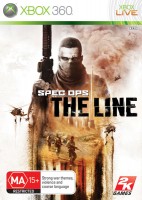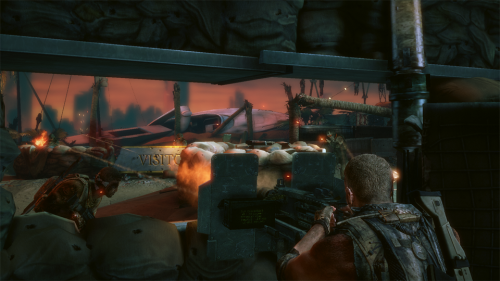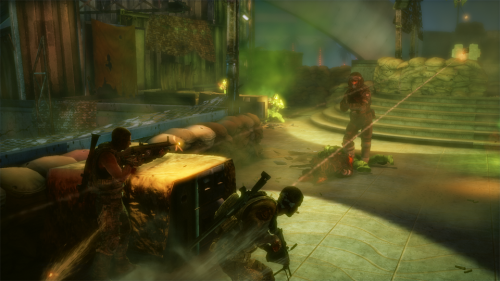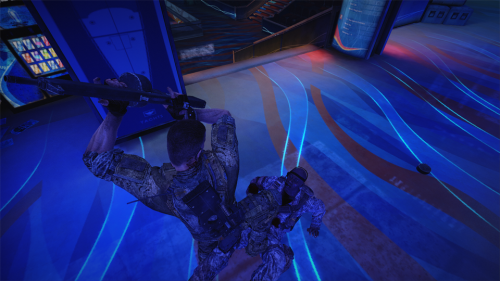On the surface, the latest iteration of Spec Ops may appear to be a military shooter indistinguishable from any number of other similar franchises, and while each series is quite unique, The Line stands apart in its objectives, bringing into question whether or not its sometimes middling gameplay is intentional, or indeed even matters at all. Its narrative and presentation hit several highs, more than expected, and while it does lean back on a trope or two, nothing detracts from the power of its messages should players be sensitive to them.
A Shattered City
The United States Flag, tattered and flying upside-down from the broken corner of a Dubai skyscraper frames the main menu that greets players on booting the game, backed by Jimi Hendrix’ live performance of The Star Spangled Banner. Starting the campaign will have the menu text fade and the opening cinematic start from the scene on display and the player is quickly thrust into a loud and desperate helicopter flight. After a short playable section, you’re returned to events that have happened prior to the flight while cinematic credits and titles are overlayed. Dubai has been hit by an extraordinary sandstorm the scale of a natural disaster, and the opulent city has been torn apart by the event.
 Players will take control of Walker and two Delta-Force soldiers Adams and Lugo investigating a distress call from the city in a third-person, cover-based shooter. As Walker, you will begin with an assault rifle and side-arm while Adams carries a light machinegun and shotgun, Lugo with a sub-machinegun and sniper rifle as you approach the city from the outskirts. Adams will often use his shotgun to breach doors, while Lugo can be commanded to snipe enemies too distant for normal fire. Commands are given by holding the right bumper on Xbox or R2 on PS3 and placing your reticle over targets, and the same action can be used to order both soldiers to fire on closer enemies with their primary weapons, tapping the button to heal one-another if one is significantly wounded or throw a flashbang grenade that the game offers if the player seems to be pinned down and not progressing. One thing the player cannot control is direct movement of squad-mates, lacking any kind of hold position or rules of engagement mode, however they’ll generally stay within range of the player so adapting to their movement habits, while not ideal, is easy.
Players will take control of Walker and two Delta-Force soldiers Adams and Lugo investigating a distress call from the city in a third-person, cover-based shooter. As Walker, you will begin with an assault rifle and side-arm while Adams carries a light machinegun and shotgun, Lugo with a sub-machinegun and sniper rifle as you approach the city from the outskirts. Adams will often use his shotgun to breach doors, while Lugo can be commanded to snipe enemies too distant for normal fire. Commands are given by holding the right bumper on Xbox or R2 on PS3 and placing your reticle over targets, and the same action can be used to order both soldiers to fire on closer enemies with their primary weapons, tapping the button to heal one-another if one is significantly wounded or throw a flashbang grenade that the game offers if the player seems to be pinned down and not progressing. One thing the player cannot control is direct movement of squad-mates, lacking any kind of hold position or rules of engagement mode, however they’ll generally stay within range of the player so adapting to their movement habits, while not ideal, is easy.
More Than A Game
Weapons on offer will vary from light machineguns to shotguns, various rifles and a few explosive weapons such as grenade launchers and RPGs. It’s tempting to compare the way the game handles these weapons, their apparent heft and behaviour, with other military shooters and find it wanting. Similarly, entering into combat may not seem as flowing and dynamic as other games and in some ways at certain points, the combat may feel monotonous. As the theme unfolds though, I began to think that this was an intentional decision. The design of this game isn’t about the detail in the weaponry, relatively high though it may be, it’s in the act of doing violence in a setting that is extreme and demands more than just primary engagement.
From the outset, the colour palette is immediately strong, painting the setting in a stark beauty of earthy, orange sand and blue sky. One thing consistent throughout the game is the stunning nature of the visuals, from environmental design to lighting, the technical appearance is almost breathtaking. Almost, because once the context of the game is clear, the nature of that beauty changes. It’s difficult to discuss the themes in detail without destroying the sense of discovery on offer for the player. The understanding of your initial mission is to search for survivors and then report back, but a rescue of U.S. soldiers attacked by locals quickly derails the primary objective.
As the game moves to the Financial Centre, you see the first of many pieces of graffiti that mark the walls of the environments throughout the game. They add an eerie, human atmosphere to the spaces, signs of real humanity that help create a strong sense of place, expressing a sense of anger and fear in the face of desperation. Things are not what they seem in shattered Dubai, and the impending feeling that difficulties lie ahead is palpable.
Trials And Fragility
Spec Ops eventually demands some truly horrifying decisions from the player. Pragmatically, these are handled quite excellently as dialogue will be delivered in-game, then the player’s actions alone (movement or fire for example) will determine which way the narrative is guided. The absence of dialogue options or a static pause to prompt the decision is fluid and refreshing, much more transparent and dynamic. One of the earliest decisions has you choosing between one horror and another and it sets the tone for how the remainder of the game will play out. It becomes evident that very little that you do will prevent bad things from happening and your thinking is shaped to choose what tragedies you will permit to achieve what you hope to be a positive outcome.
While the opening tutorial area of the first level has Adams and Lugo giving some entertaining and light hearted soldier-banter, this quickly dissolves after the first decision point as they disagree with one-another, including one of them inevitably disagreeing with your decision. Your companions will constantly question your decisions and struggle to cope with the horrors of combat that will unfold, indeed Walker himself will inevitably lose confidence in reconciling what he sees and does. The themes of the horror of conflict, of civilian desperation and the struggle for basic survival take over, so much so that the mechanics of combat become secondary to context. True enough, you and your soldiers will bark affirming celebrations at downing an enemy but it’s bitter and harrowing, always brought back into the context of the chaos. Combatants aren’t just enemies to gun down, your companions aren’t just tools to assist you in your goal, civilians aren’t just throw-away animations to populate the space. Everyone here is desperate to survive.
Play And Presentation
There are some practical things worth mentioning as I try not to again get swept up in the theme. For those unfamiliar with cover shooters, the player controlled character can snap into cover with a button press, swap between and run from cover to cover and pop out of cover to aim with the left trigger, releasing it to return to cover. Even on the Normal difficulty setting, there is a constant ammunition shortage as you play that forces you to scavenge weapons from downed enemies. Coupled with this are the odd weapons that are found littering certain areas and the restriction of two weapons in total regardless of size. Choosing one tool in place of another provides both significant advantages and limitations, making every option to swap out weapons crucial. Many weapons have two firing modes, be they fully automatic and triple burst fire, normal and scoped views, underslung 40mm grenade launcher or a switchable laser guide, and clip-size and ammunition on hand are all important tactical considerations given the scarcity of general ammunition boxes to replenish whatever is equipped. Accompanying the selection of firearms are three grenade types, fragmentation, sticky and flashbang, all of which are useful at some point.
Further on practicalities, there are some nice details about the place, the aforementioned graffiti which is a constantly recurring motif, and also the camelbacks that you and your squad wear. They’re just a nice little piece of attention to detail given that these soldiers would be trekking through a desert environment. Controlling the camera with the right stick will also have Walker turn his head to follow your field of vision, subtly emphasising your participation and control of his character.
Fear From All Sides
Among other great details, the instances of the sandstorm are possibly the most important. They look amazing as they transform spaces by closing them in with a thick, orange haze, but they also represent the biggest threat to you as you struggle through low visibility combat, and in the sense that the storm and the desert can kill everyone in Dubai. Threats are everywhere, whether they come in the form of the environment, aggressive combatants or a terrible decision you may be forced to make.
I’m torn between applauding Yager’s successful creation of a terrifying humanitarian and ethical situation when it deftly presents them, and perhaps being over-critical of some subtle missed opportunities. The game may not be the most exciting mechanically, but it certainly is challenging and thought provoking in its theme and acts as a powerful piece of commentary on the atrocities of natural disasters interrupting normal order, and the possibility of ensuing combat and military action in the face of it. Because so much is done well, at its conclusion I guess I wanted it to push further as the very end may be interpreted as slightly weak given the themes presented. It brings me to question the inclusion of a multiplayer component when such good questions are being posed with the single-player narrative, almost at odds with the message at hand as a necessary commercial inclusion. Who knows, perhaps even that itself is commentary.
With difficulty set to Normal, my playthrough took about 10 hours, including a few instances of deaths and checkpointing. Reloading checkpoints may seem to take a little longer than what is ideal, but I overlooked them as I did the necessity to restart in the face of difficult combat. It wasn’t about me getting frustrated with the mechanics of the game at all, as the monotony of repeated combat only reinforced the harrowing, meaningful experience.
A Worthy Achievement
Over the last few years, questions have been asked whether a game has to be fun in order to be good – that may be heavily summarising the question, but the spirit of it is there. I’ve always wanted to take the side that fun isn’t necessary, but I struggled to appreciate how it could be done, and done well. Spec Ops: The Line may very well be the first, solid example of such an experience. It’s a game that may not have a single moment of triumph in it, at best, only exhausted acceptance of fragility and moral dilemma. It’s a game I will play again, but not to relive exciting, climactic set-pieces or moments of empowerment in gameplay dynamic, but to reflect on the sense of place, development of characters and themes.
Lastly, there are one or two collectible items per chapter, most found quite easily, offering audio-clips that add to the narrative. Each one is significant and helps develop the story quite well, including one in particular that closes with a remark from Walker: “The cost of our presence here continues to grow.”















